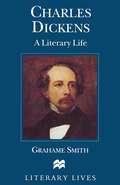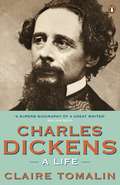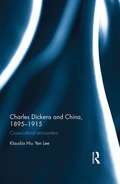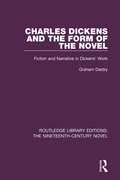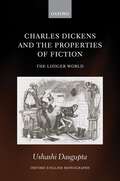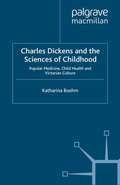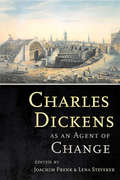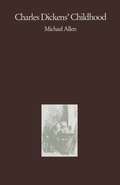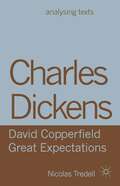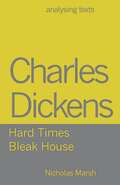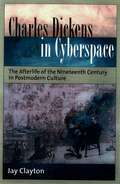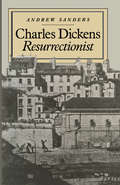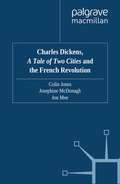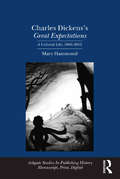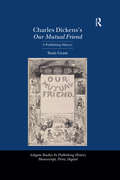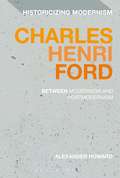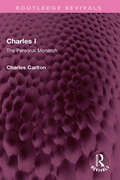- Table View
- List View
Charles Dickens: A Literary Life (Literary Lives)
by Grahame SmithThis study of Dickens's career as a professional writer uses a range of material to describe and analyze the ways in which his work can be seen as a form of literary production. It thus offers a challenge to traditional accounts which stress the private nature of Dickens's genius. Smith focuses on the communal nature of Dickens's achievement in his struggles with publishers, the expectations of a vast public, and the demands of serialization.
Charles Dickens: A Life
by Claire TomalinCharles Dickens is the acclaimed definitive biography by bestselling author Claire Tomalin Charles Dickens was a phenomenon: a demonicly hardworking journalist, the father of ten children, a tireless walker and traveller, a supporter of liberal social causes, but most of all a great novelist - the creator of characters who live immortally in the English imagination: the Artful Dodger, Mr Pickwick, Pip, David Copperfield, Little Nell, Lady Dedlock, and many more.At the age of twelve he was sent to work in a blacking factory by his affectionate but feckless parents. From these unpromising beginnings, he rose to scale all the social and literary heights, entirely through his own efforts. When he died, the world mourned, and he was buried - against his wishes - in Westminster Abbey.Yet the brilliance concealed a divided character: a republican, he disliked America; sentimental about the family in his writings, he took up passionately with a young actress; usually generous, he cut off his impecunious children. From the award-winning author of Samuel Pepys, Charles Dickens: A Life paints an unforgettable portrait of Dickens, capturing brilliantly the complex character of this great genius. If you loved Great Expectations, Oliver Twist and A Christmas Carol, this book is invaluable reading.'By far the most humane and imaginatively sympathetic account yet for the general reader' Amanda Craig, New StatesmanClaire Tomalin is the award-winning author of eight highly acclaimed biographies, including: The Life and Death of Mary Wollstonecraft; Shelley and His World; Katherine Mansfield: A Secret Life; The Invisible Woman: The Story of Nelly Ternan and Charles Dickens; Mrs Jordan's Profession; Jane Austen: A Life; Samuel Pepys: The Unequalled Self; Thomas Hardy: The Time-Torn Man and, most recently, Charles Dickens: A Life. A former literary editor of the New Statesman and the Sunday Times, she is married to the playwright and novelist Michael Frayn.
Charles Dickens and China, 1895-1915: Cross-Cultural Encounters
by Klaudia Hiu LeeFrom 1895 to 1915, Chinese translations of Dickens's fiction first appeared as part of a growing interest in Western literature and culture among Chinese intellectuals. Klaudia Hiu Yen investigates the multifarious ways in which Dickens’s works were adapted, reconfigured, and transformed for the Chinese readership against the turbulent political and social conditions in the last stages of the Qing dynasty (1644-1912) and the early Republic (1912-1949). Moving beyond the 'Response to the West’ model which often characterises East-West interactions, Lee explores how Chinese intellectuals viewed Dickens’s novels as performing a particular social function; on occasion, they were used to advance the country’s social and political causes. Translation and adaptation became a means through which the politics and social values of the original Dickens texts were undermined or even subverted. Situating the early introduction of Dickens to China within the broader field of Victorian studies, Lee challenges some of the theoretical and conceptual underpinnings of the ’global’ turn, both in Dickens scholarship and in Victorian studies in general.
Charles Dickens and China, 1895-1915: Cross-Cultural Encounters
by Klaudia Hiu LeeFrom 1895 to 1915, Chinese translations of Dickens's fiction first appeared as part of a growing interest in Western literature and culture among Chinese intellectuals. Klaudia Hiu Yen investigates the multifarious ways in which Dickens’s works were adapted, reconfigured, and transformed for the Chinese readership against the turbulent political and social conditions in the last stages of the Qing dynasty (1644-1912) and the early Republic (1912-1949). Moving beyond the 'Response to the West’ model which often characterises East-West interactions, Lee explores how Chinese intellectuals viewed Dickens’s novels as performing a particular social function; on occasion, they were used to advance the country’s social and political causes. Translation and adaptation became a means through which the politics and social values of the original Dickens texts were undermined or even subverted. Situating the early introduction of Dickens to China within the broader field of Victorian studies, Lee challenges some of the theoretical and conceptual underpinnings of the ’global’ turn, both in Dickens scholarship and in Victorian studies in general.
Charles Dickens and the Form of the Novel: Fiction and Narrative in Dickens' Work (Routledge Library Editions: The Nineteenth-Century Novel)
by Graham DaldryFirst published in 1987. While there have been commentaries on his humour, his seriousness, his social concerns, and other specific aspects of his work such accounts have only tended to divide our understanding of the novels, to lead us to see them as failures of artistic unity. In this book the author seeks to address this question of unity and find a terminology that can treat language, plot and representation of reality as a coherent imaginative effort. This thesis is worked out in detail with reference to several of the novels, and represents a challenging re-evaluation Dickens’ achievement as a novelist. This book will be if interest to student of literature.
Charles Dickens and the Form of the Novel: Fiction and Narrative in Dickens' Work (Routledge Library Editions: The Nineteenth-Century Novel)
by Graham DaldryFirst published in 1987. While there have been commentaries on his humour, his seriousness, his social concerns, and other specific aspects of his work such accounts have only tended to divide our understanding of the novels, to lead us to see them as failures of artistic unity. In this book the author seeks to address this question of unity and find a terminology that can treat language, plot and representation of reality as a coherent imaginative effort. This thesis is worked out in detail with reference to several of the novels, and represents a challenging re-evaluation Dickens’ achievement as a novelist. This book will be if interest to student of literature.
Charles Dickens and the Properties of Fiction: The Lodger World (Oxford English Monographs)
by Ushashi DasguptaWhen Dickens was nineteen years old, he wrote a poem for Maria Beadnell, the young woman he wished to marry. The poem imagined Maria as a welcoming landlady offering lodgings to let. Almost forty years later, Dickens died, leaving his final novel unfinished - in its last scene, another landlady sets breakfast down for her enigmatic lodger. These kinds of characters are everywhere in Dickens's writing. Charles Dickens and the Properties of Fiction: The Lodger World explores the significance of tenancy in his fiction. In nineteenth century Britain the vast majority of people rented, rather than owned, their homes. Instead of keeping to themselves, they shared space - renting, lodging, taking lodgers in, or simply living side-by-side in a crowded modern city. Charles Dickens explored both the chaos and the unexpected harmony to be found in rented spaces, the loneliness and sociability, the interactions between cohabitants, the complex gender dynamics at play, and the relationship between space and money. Charles Dickens and the Properties of Fiction demonstrates that a cosy, secluded home life was beyond the reach of most Victorian Londoners, and considers Dickens's nuanced conception of domesticity. Tenancy maintained an enduring hold upon his imagination, giving him new stories to tell and offering him a set of models to think about authorship. He celebrated the fact that unassuming houses brim with narrative potential: comedies, romances, and detective plots take place behind their doors. Charles Dickens and the Properties of Fiction: The Lodger World wedges these doors open.
Charles Dickens and the Properties of Fiction: The Lodger World (Oxford English Monographs)
by Ushashi DasguptaWhen Dickens was nineteen years old, he wrote a poem for Maria Beadnell, the young woman he wished to marry. The poem imagined Maria as a welcoming landlady offering lodgings to let. Almost forty years later, Dickens died, leaving his final novel unfinished - in its last scene, another landlady sets breakfast down for her enigmatic lodger. These kinds of characters are everywhere in Dickens's writing. Charles Dickens and the Properties of Fiction: The Lodger World explores the significance of tenancy in his fiction. In nineteenth century Britain the vast majority of people rented, rather than owned, their homes. Instead of keeping to themselves, they shared space - renting, lodging, taking lodgers in, or simply living side-by-side in a crowded modern city. Charles Dickens explored both the chaos and the unexpected harmony to be found in rented spaces, the loneliness and sociability, the interactions between cohabitants, the complex gender dynamics at play, and the relationship between space and money. Charles Dickens and the Properties of Fiction demonstrates that a cosy, secluded home life was beyond the reach of most Victorian Londoners, and considers Dickens's nuanced conception of domesticity. Tenancy maintained an enduring hold upon his imagination, giving him new stories to tell and offering him a set of models to think about authorship. He celebrated the fact that unassuming houses brim with narrative potential: comedies, romances, and detective plots take place behind their doors. Charles Dickens and the Properties of Fiction: The Lodger World wedges these doors open.
Charles Dickens and the Sciences of Childhood: Popular Medicine, Child Health and Victorian Culture (Palgrave Studies in Nineteenth-Century Writing and Culture)
by K. BoehmThis book takes a fresh look at childhood in Dickens' works and in Victorian science and culture more generally. It offers a new way of understanding Dickens' interest in childhood by showing how his fascination with new scientific ideas about childhood and practices of scientific inquiry shaped his narrative techniques and aesthetic imagination.
Charles Dickens as an Agent of Change
Sixteen scholars from across the globe come together in Charles Dickens as an Agent of Change to show how Dickens was (and still is) the consummate change agent. His works, bursting with restless energy in the Inimitable's protean style, registered and commented on the ongoing changes in the Victorian world while the Victorians' fictional and factional worlds kept (and keep) changing. The essays from notable Dickens scholars—Malcolm Andrews, Matthias Bauer, Joel J. Brattin, Doris Feldmann, Herbert Foltinek, Robert Heaman, Michael Hollington, Bert Hornback, Norbert Lennartz, Chris Louttit, Jerome Meckier, Nancy Aycock Metz, David Paroissien, Christopher Pittard, and Robert Tracy—suggest the many ways in which the notion of change has found entry into and is negotiated in Dickens' works through four aspects: social change, political and ideological change, literary change, and cultural change. An afterword by the late Edgar Rosenberg adds a personal account of how Dickens changed the life of one eminent Dickensian.
Charles Dickens: David Copperfield/ Great Expectations (Analysing Texts)
by Nicolas TredellDavid Copperfield and Great Expectations are among Charles Dickens's most famous novels. In both books, the hero tells the vivid and absorbing tale of his education by life, presents a rich range of characters and scenes, and tackles profound moral, social and psychological themes.Part I of this essential study:• provides lucid and penetrating analyses of key passages• discusses the crucial topics of patriarchy, class, obsession, eccentricity, death, breakdown and recovery• summarizes the methods of analysis and offers suggestions for further work.Part II supplies key background material, including:• an account of Dickens's life and works• a survey of historical, cultural and literary contexts• samples of significant criticism.Also featuring a valuable Further Reading section, this volume provides readers with the critical and analytical skills which will enable them to enjoy and explore both novels for themselves.
Charles Dickens: David Copperfield/ Great Expectations (Analysing Texts)
by Nicolas TredellDavid Copperfield and Great Expectations are among Charles Dickens's most famous novels. In both books, the hero tells the vivid and absorbing tale of his education by life, presents a rich range of characters and scenes, and tackles profound moral, social and psychological themes.Part I of this essential study:- Provides lucid and penetrating analyses of key passages- Discusses the crucial topics of patriarchy, class, obsession, eccentricity, death, breakdown and recovery- Summarizes the methods of analysis and offers suggestions for further workPart II supplies key background material, including:- An account of Dickens's life and works- A survey of historical, cultural and literary contexts- Samples of significant criticismAlso featuring a valuable Further Reading section, this volume provides readers with the critical and analytical skills which will enable them to enjoy and explore both novels for themselves.
Charles Dickens - Hard Times/Bleak House (Analysing Texts)
by Nicholas MarshThis stimulating study takes a fresh look at two of Dickens' most widely-studied texts. Part I uses carefully selected short extracts for close textual analysis, while Part II examines the historical and literary contexts and key criticism. The volume is an ideal introductory guide for those who are studying Dickens' novels for the first time.
Charles Dickens - Hard Times/Bleak House (Analysing Texts)
by Nicholas MarshThis stimulating study takes a fresh look at two of Dickens' most widely-studied texts. Part I uses carefully selected short extracts for close textual analysis, while Part II examines the historical and literary contexts and key criticism. The volume is an ideal introductory guide for those who are studying Dickens' novels for the first time.
Charles Dickens in Cyberspace: The Afterlife of the Nineteenth Century in Postmodern Culture
by Jay ClaytonCharles Dickens in Cyberspace opens a window on a startling set of literary and scientific links between contemporary American culture and the nineteenth-century heritage it often repudiates. Surveying a wide range of novelists, scientists, filmmakers, and theorists from the past two centuries, Jay Clayton traces the concealed circuits that connect the telegraph with the Internet, Charles Babbage's Difference Engine with the digital computer, Frankenstein's monster with cyborgs and clones, and Dickens' life and fiction with all manner of contemporary popular culture--from comic books and advertising to recent novels and films. In the process, Clayton argues for two important principles: that postmodernism has a hidden or repressed connection with the nineteenth-century and that revealing those connections can aid in the development of a historical cultural studies. In Charles Dickens in Cyberspace nineteenth-century figures--Jane Austen, Charles Darwin, Charles Dickens, Thomas Hardy, Henry James, Ada Lovelace, Joseph Paxton, Mary Shelley, and Mary Somerville--meet a lively group of counterparts from today: Andrea Barrett, Greg Bear, Peter Carey, Hélène Cixous, Alfonso Cuarón, William Gibson, Donna Haraway, David Lean, Richard Powers, Salman Rushdie, Ridley Scott, Susan Sontag, Neal Stephenson, Bruce Sterling, and Tom Stoppard. The juxtaposition of such a diverse cast of characters leads to a new way of understanding the "undisciplined culture" the two eras share, an understanding that can suggest ways to heal the gap that has long separated literature from science. Combining storytelling and scholarship, this engaging study demonstrates in its own practice the value of a self-reflective stance toward cultural history. Its personal voice, narrative strategies, multiple points of view, recursive loops, and irony emphasize the improvisational nature of the methods it employs. Yet its argument is serious and urgent: that the afterlife of the nineteenth century continues to shape the present in diverse and sometimes conflicting ways.
Charles Dickens, A Tale of Two Cities and the French Revolution (Palgrave Studies in Nineteenth-Century Writing and Culture)
by C. Jones J. McDonagh J. MeeA Tale of Two Cities has always been one of Dickens's most popular texts. Using a variety of disciplinary approaches, this new collection of essays examines the origins of Dickens vision of the French Revolution, the literary power of the text itself, and its enduring place in British culture through stage and screen adaptations.
Charles Dickens's Great Expectations: A Cultural Life, 1860–2012
by Mary HammondGreat Expectations has had a long, active and sometimes surprising life since its first serialized appearance in All the Year Round between 1 December 1860 and 3 August 1861. In this new publishing and reception history, Mary Hammond demonstrates that while Dickens’s thirteenth novel can tell us a great deal about the dynamic mid-Victorian moment into which it was born, its afterlife beyond the nineteenth-century Anglophone world reveals the full extent of its versatility. Re-assessing generations of Dickens scholarship and using newly discovered archival material, Hammond covers the formative history of Great Expectations' early years, analyses the extent and significance of its global reach, and explores the ways in which it has functioned as literature and stage, TV, film and radio drama from its first appearance to the latest film version of 2012. Appendices include contemporary reviews and comprehensive bibliographies of adaptations and translations. The book is a rich resource for scholars and students of Dickens; of comparative literature; and of publishing, readership, and media history.
Charles Dickens's Great Expectations: A Cultural Life, 1860–2012 (Ashgate Studies In Publishing History: Manuscript, Print, Digital Ser.)
by Mary HammondGreat Expectations has had a long, active and sometimes surprising life since its first serialized appearance in All the Year Round between 1 December 1860 and 3 August 1861. In this new publishing and reception history, Mary Hammond demonstrates that while Dickens’s thirteenth novel can tell us a great deal about the dynamic mid-Victorian moment into which it was born, its afterlife beyond the nineteenth-century Anglophone world reveals the full extent of its versatility. Re-assessing generations of Dickens scholarship and using newly discovered archival material, Hammond covers the formative history of Great Expectations' early years, analyses the extent and significance of its global reach, and explores the ways in which it has functioned as literature and stage, TV, film and radio drama from its first appearance to the latest film version of 2012. Appendices include contemporary reviews and comprehensive bibliographies of adaptations and translations. The book is a rich resource for scholars and students of Dickens; of comparative literature; and of publishing, readership, and media history.
Charles Dickens's Our Mutual Friend: A Publishing History (Studies in Publishing History: Manuscript, Print, Digital)
by Sean GrassEven within the context of Charles Dickens's history as a publishing innovator, Our Mutual Friend is notable for what it reveals about Dickens as an author and about Victorian publishing. Marking Dickens's return to the monthly number format after nearly a decade of writing fiction designed for weekly publication in All the Year Round, Our Mutual Friend emerged against the backdrop of his failing health, troubled relationship with Ellen Ternan, and declining reputation among contemporary critics. In his subtly argued publishing history, Sean Grass shows how these difficulties combined to make Our Mutual Friend an extraordinarily odd novel, no less in its contents and unusually heavy revisions than in its marketing by Chapman and Hall, its transformation from a serial into British and U.S. book editions, its contemporary reception by readers and reviewers, and its delightfully uneven reputation among critics in the 150 years since Dickens’s death. Enhanced by four appendices that offer contemporary accounts of the Staplehurst railway accident, information on archival materials, transcripts of all of the contemporary reviews, and a select bibliography of editions, Grass’s book shows why this last of Dickens’s finished novels continues to intrigue its readers and critics.
Charles Dickens's Our Mutual Friend: A Publishing History (Studies in Publishing History: Manuscript, Print, Digital)
by Sean GrassEven within the context of Charles Dickens's history as a publishing innovator, Our Mutual Friend is notable for what it reveals about Dickens as an author and about Victorian publishing. Marking Dickens's return to the monthly number format after nearly a decade of writing fiction designed for weekly publication in All the Year Round, Our Mutual Friend emerged against the backdrop of his failing health, troubled relationship with Ellen Ternan, and declining reputation among contemporary critics. In his subtly argued publishing history, Sean Grass shows how these difficulties combined to make Our Mutual Friend an extraordinarily odd novel, no less in its contents and unusually heavy revisions than in its marketing by Chapman and Hall, its transformation from a serial into British and U.S. book editions, its contemporary reception by readers and reviewers, and its delightfully uneven reputation among critics in the 150 years since Dickens’s death. Enhanced by four appendices that offer contemporary accounts of the Staplehurst railway accident, information on archival materials, transcripts of all of the contemporary reviews, and a select bibliography of editions, Grass’s book shows why this last of Dickens’s finished novels continues to intrigue its readers and critics.
Charles Henri Ford: Between Modernism and Postmodernism (Historicizing Modernism)
by Alexander HowardThe first American surrealist poet, a prolific literary editor and a seminal influence on the New York School of poetry, Charles Henri Ford was a key figure in the transition from late modernist to postmodern culture in America. Charles Henri Ford: Between Modernism and Postmodernism is the first book-length scholarly study of this important literary figure. Drawing on new archival research – including explorations of Ford's correspondence with the likes of Ezra Pound, Gertrude Stein, William Carlos Williams, Parker Tyler, and many others – the book explores the full impact of Ford's contribution to 20th-century American literary culture.
Charles Henri Ford: Between Modernism and Postmodernism (Historicizing Modernism)
by Dr Alexander HowardThe first American surrealist poet, a prolific literary editor and a seminal influence on the New York School of poetry, Charles Henri Ford was a key figure in the transition from late modernist to postmodern culture in America. Charles Henri Ford: Between Modernism and Postmodernism is the first book-length scholarly study of this important literary figure. Drawing on new archival research – including explorations of Ford's correspondence with the likes of Ezra Pound, Gertrude Stein, William Carlos Williams, Parker Tyler, and many others – the book explores the full impact of Ford's contribution to 20th-century American literary culture.
Charles I: The Personal Monarch (Routledge Revivals)
by Charles CarltonFirst published in 1995, Charles I is a psychological portrait of the ‘monarch of the Civil Wars,’ Charles I. Challenging conventional interpretations of the king, as well as questioning orthodox historical assumptions concerning the origins and development of the Civil Wars, the book establishes itself as a definitive biography. Addressing and analysing the furious historiographical debates which have surrounded the period, Carlton offers a fresh and lucid perspective. This book will be of interest to students of literature and history.
